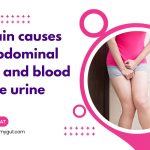5 Mimics of Gallbladder Pain (Biliary Colic): Gastroenterologist Explains.
Our content is not intended nor recommended as a substitute for medical advice by your doctor. Use for informational purposes only.
The most common cause of gallbladder pain is biliary colic resulting from a gallstone.
Uncomplicated gallstones produce characteristic biliary-type gallbladder pain.
The characteristic of biliary colic is explained in the below table:
| Biliary colic (Uncomplicated gallstone). | Description |
| 1. Site | Usually, The right upper quadrant of your abdomen |
| 2. Spread | – The pain may spread to the back of the right shoulder. – Also, it spreads to the epigastric area. |
| 3. Character | Constant builds up then disappeared gradually. |
| 4. Duration | At least 30 minutes. It may last up to 6 hours. |
| 5. Relation to food | – Triggered by foods (especially fatty food and large meals. – However, it can start spontaneously. |
| 6. NOT related to: | Movement, bowel movements, nor the passage of flatus. |
| 7. Nausea | Often Present, severe. |
| 8- Commonly associated symptoms | Vomiting, sweating during the attack. |
| 9. Unusual symptoms. | – Heartburn and chest pain. – Bloating, fullness. – Early satiety. – Isolated epigastric pain. |
| 10. Symptoms NOT associated: | – Fever. – Jaundice. – Prolonged pain for more than 6 hours. – Extreme tenderness over the gallbladder (Murphy’s sign). – Vomiting of blood, blackish stool (PUD). |
The following condition can mimic gallbladder pain:
- Gastritis and gallbladder disease.
- Acute cholecystitis: gallbladder infection as a complication of gallstones.
- Cholidolethiasis: The obstruction of the common bile duct with gallstones.
- Sphincter of Oddi dysfunction.
- Functional gallbladder disease.
- Others: gallstone pancreatitis, hepatitis, liver abscess, liver cancer, and right rib cage pain.
1. Peptic ulcer disease.
The term (peptic ulcer disease) refers to ulcers in your stomach or duodenum. Peptic ulcer disease pain can mimic gallbladder pain (biliary colic).
The main characteristic is that peptic ulcer pain is located in the upper middle part of your abdomen (epigastric area). In addition, biliary colic is often in the right upper quadrant of your abdomen and spread to the back of the right shoulder.
Nausea, bloating, abdominal fullness, and heartburn are shared features.
The below table illustrates the main differences between ulcer pain and gallbladder pain:
| Gallbladder pain (biliary colic). | Peptic ulcer pain | |
| 1. Site (typical) | Right-upper abdomen. | Mid-upper abdomen (epigastric) |
| 2. Spread) | To the right-back and to the epigastric area. | Sometimes, to the mid-upper back. |
| 3. Character | Constant. It builds up over 30-60 minutes then resolves gradually. | Constant gnawing or dull aching pain. It starts gradually and may last for several days. |
| 4. Duration | – At least 30 minutes. – Maximum is 6 hours. |
Several hours to several days or weeks. |
| 5. Pain intensity | +++++ | +++ or ++++ |
| 6. Nausea & vomiting | +++ | ++ |
2 . Acute Cholecystitis.
Acute cholecystitis is different from biliary colic. Acute cholecystitis is a complication of gallstones.
Acute cholecystitis is severe inflammation in the gallbladder. It is usually due to prolonged obstruction of the gallbladder opening by a stone. The blockage triggers inflammation and infection inside the gallbladder.
Typically, it has biliary colic as described with uncomplicated gallstones. However, the following differences help you to differentiate.
- The gallbladder pain is often more severe and steady.
- The biliary colic is often more prolonged (pain lasting for more than 6 hours usually indicates acute cholecystitis or bile duct stone).
- Radiation to the right shoulder or back is more common.
- Fever and ill-feeling are frequent.
- Severe localized tenderness above the gallbladder area (The right-upper quadrant just below the rib cage). The severe local tenderness over the gallbladder area is Murphy’s sign (absent on uncomplicated biliary colic).
- Nausea and vomiting are more common.
MORE:
3. Bile duct stone (cholelithiasis).
When the stone escapes the gallbladder, it may impact the duct that connects the gallbladder to the duodenum (common bile duct).
The stone impaction in the gallbladder opening obstructs bile outflow from the gallbladder. But stone impaction in the common bile duct prevents the bile outflow from the gallbladder and the liver (complete bile outflow obstruction).
The impaction triggers two groups of symptoms:
- Symptoms that are similar to acute cholecystitis.
- Symptoms of bile outflow obstruction.
The following are differences from uncomplicated biliary colic:
- Prolonged biliary colic (more than 6 hours).
- More severe and constant pain.
- Jaundice (a yellowish color of your skin and eye whites.
- Dark urine (tea-colored).
- Clay (pale grayish) stool.
- Itching.
- Fever also occurs.
- Your doctor confirms the condition by laboratory tests (showing elevated bilirubin levels) and imaging (showing dilated common bile ducts).
Often, bile duct obstruction requires urgent relief of the block by a particular type of upper endoscopy called ERCP (Endoscopic Retrograde Cholangiopancreatography).
4. Sphincter of Oddi dysfunction.
The common bile duct (CBD) delivers the bile to the duodenum. Then, the CBD unites the pancreatic duct near its end, forming a single duct called (the ampulla of Vater). The ampulla of Vater opens into the duodenum.
The opening is encircled by a ring of muscle called (the sphincter of Oddi). Sphincter of Oddi dysfunction describes the abnormal obstruction of the bile and pancreatic secretions due to abnormal structure or function of the Sphincter.
Sphincter of Oddi dysfunction mimics gallbladder pain. It also can cause symptoms of pancreatitis.
It is rare, and difficult to diagnose disease. Studies show that women are more affected by SOD than men (reference).
5. Functional Gallbladder disease.
Functional gallbladder disease mimics gallbladder pain (biliary colic) 100%. The only difference is the pain occurs without the presence of gallstones.
Patients with functional gallbladder disease have typical biliary type pain mimicking the gallstone disease:
- Right upper quadrant pain that spreads to the back and the epigastric area.
- It often starts after fatty meals.
- It builds up and lasts from 30 minutes up to 6 hours.
- Associated with loss of appetite, nausea, and sometimes vomiting.
6. Others.
A. Pancreatitis.
Acute inflammation of the pancreas can mimic gallbladder disease. As a result, gallstones can obstruct the pancreatic duct causing pancreatitis. Gallstones are one of the most common causes of pancreatitis.
The main differences are:
- the pain is more severe and constant for many hours or days.
- The pain localizes in the upper stomach in the middle (epigastric pain).
- It is associated with severe vomiting.
- The pain partially improves by learning words.
- It can be associated with fever, abdominal tenderness, and loss of appetite.
Pancreatitis after Gallbladder Removal: Incidence, Causes, and Mimics.
B. Liver pain.
Pain arising from the liver is often due to:
- Liver cancer (primary liver cancer or metastasis from other cancer).
- Liver inflammation (acute hepatitis).
- Liver abscess.
- Liver trauma (injury).
The liver pain is dull, aching, and constant pain. It is not of the biliary type. Liver pain is generally less severe and more prolonged than gallbladder pain.
RELATED: Does Your Liver Cause Pain After Eating?
C. Right Pleurisy.
Pleura is a double-layered lung envelope. Inflammation of the right-lower lung pleura can cause pain that mimics gallbladder pain.
The pleurisy pain is often related to movement, respiration, and cough. It is pricking or stretching in nat bure. It usually lasts for days and is not associated with nausea, vomiting, and food.
D. Bone and muscle pain (right rib cage).
Pain from muscle strains, rib bone fractures, or rib bone disease on the right side can mimic gallbladder pain. However, it is often more localized and related to movement.
Bone and muscle pain are not associated with food. Also, there are no gastrointestinal associated symptoms such as nausea and vomiting.
- Evidence-based
- Written by a doctor.







